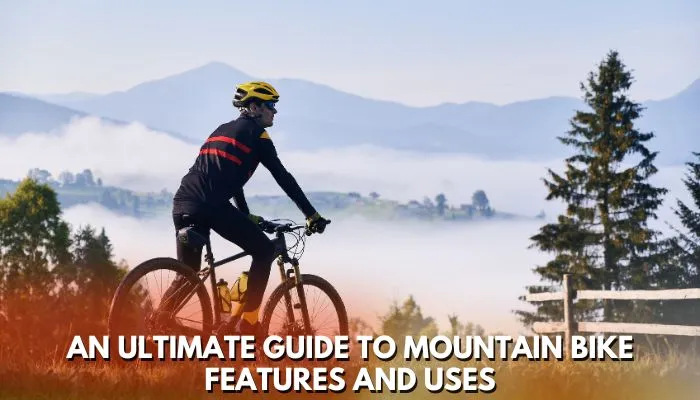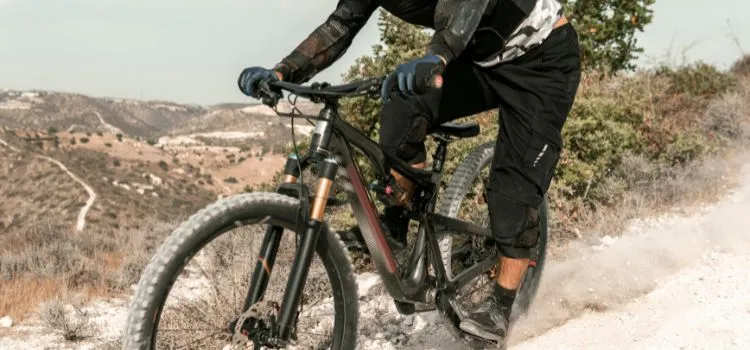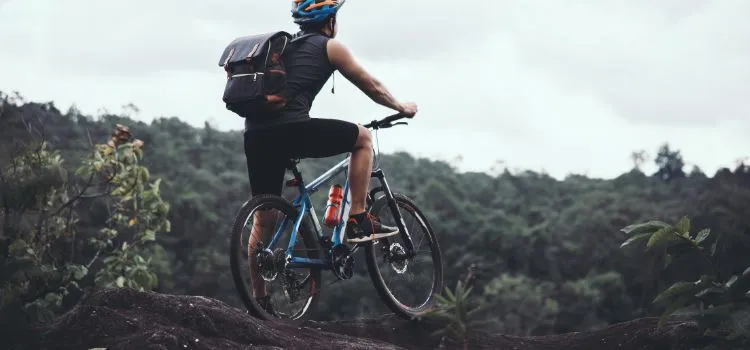An Ultimate Guide to Mountain Bike Features and Uses

Off-road bicycles, sometimes known as mountain bikes, aim specifically to ride on rocky, uneven surfaces. Their design and appearance are different from bikes used for road cycling.
Table of Contents
Short Answer
Among mountain bike features, groupsets, tire sizes, geometry, frame materials, bike handlebars, brakes, futureproofing, gearing, weight, suspension, and dimensions of the bike, as well as motors, should be considered.
A mountain bike is the most incredible option for folks who like to ride up mountain paths or through dense forests. When talking about mountain bikes, there are several things to consider, including bike designs, versatility, aspects of design, and a lot more. This article covers all the features and uses of mountain bikes. So, read this article to get knowledge about this.
What is a Mountain Bike?

A mountain bike is beneficial compared to a regular bicycle due to its possibility of riding on a rough surface rather than the road. Although the title Mountain gives the impression that the bike is best for rugged, harsh terrain, it is the perfect all-arounder. These bicycles have components that can enhance effectiveness on a variety of terrain.
Mountain Bike Features:
The following are the significant features of mountain bikes.
- Mountain Bike Frame
Mountain bikes feature a frame, which is a particular part of the bike. They can resist the most difficult rugged excursions since they are more robust than your standard bike frame.
- Weight
While weight is an important consideration when buying a bike, mountain bikes often prioritize sturdiness. You must understand that fragile components are useless in combating scratches, pebbles, and roots in tricky terrain. Additionally, more significant weight effect lighter-frame metals badly.
- The Suspensions
Hardtail or full-suspension mountain bike models are typically the only types you consider. Both may have advantages and disadvantages. For those on a budget, the simple hardtails are effective.
They are bikes with only front-wheel suspension and substantially better specifications than their price. Additionally, they are considerably lighter than their full-suspension versions.
A hardtail will be the obvious choice if you consider cycling while climbing. The engine and wheel connect with them. This allows for responsive reactions with lighter pedaling. Hardtails are also simpler to look after overall.
Although inexpensive, they don’t require extensive maintenance. Full suspension, on the other hand, is more fundamental. They work for specific off-road experiences and are sturdy enough for more challenging treks. In addition, some mountain bikes come with air or spring suspension. However, this is less prevalent.
- Groupset
Your derailleur, chain, chairing, crank, shifter, and cassette make up your groupset. Improving your mountain bike’s sturdiness, effectiveness, and switching effectiveness is frequently merely a closed-circuit benefit. Low-grade metals are typically the only materials used in entry-level bicycles, while higher-end models use steel or carbon fiber.
- Motors
Electrical mountain bikes are more prevalent compared to today. They incorporate a battery and motor and adhere to comparable rules to conventional mountain bikes. They merely provide a level of support that allows it simpler to increase your pedaling effort.
- Tire Dimensions
As I can understand, there hadn’t been much variance in tire sizes for a while. Mountain bike tires of 26 inches are standard among manufacturers. Mountain bikes designed for downhill and dirt jumps are the only exceptions to this rule. In those situations, bigger frames are a priority.
New grownup bicycles, however, can also have tired of a 27.5-inch or 29-inch size. These have the advantage of having better speed capacity for carrying. It’s essential to know that these more recent tires have some limitations. They result in harder corners and shorter surges in general. This is not a major issue, but it can restrict active riding techniques.
- Seat
Smaller seats are something to check for when buying a mountain bike. Over roots and stones, they promote more fluid motion. On the other hand, a more elevated seated posture would offer greater energy and make ascents simpler. However, a lot will depend on the routes you intend to take. The more elevated seat bars won’t be an issue if you only desire a relaxing ride on a green countryside road. There’s not much that might go bad, have an elevated seat on the mountain bike because you aren’t going to worry about your toes touching the ground during rapid stopping.
Rockier terrain, on the other hand, requires flexibility. You must adapt to various terrains; thus, you must jump frequently. More elevated posts would therefore be unpleasant.
- Brakes
Disc brakes are a common mountain bike feature, and they are always recommended as the first choice. They provide adequate halting force in any circumstance while being dependable and long-lasting. Additionally, there are numerous dimensions, forms, and types of disc brakes.
Brakes can be mechanical, or cable-operated. In addition to being more reliable and more robust, hydraulic brakes also reduce the temperature more quickly during brutal declines. At the same time, cable brakes are more simple and less expensive.
- Handlebars
Handlebars are likely the most apparent distinction between road bikes and mountain bikes. The handlebars of road bikes are typically bent and confined, whereas those of mountain bikes are straighter and larger.
This is since handling and shifting are a top priority on mountain bikes. Also, it makes it logical because you would want the most steadiness available in tricky landscapes. This is precisely what bigger handlebars do. You can easily lift your bike across uneven terrain by holding it up high with your hands.
Mountain Bikes Uses

Mountain bikes are used in a variety of ways. Nowadays, people are using Mountain bikes for different purposes. Some uses of Mountain bikes are as follows:
- Traveling
Traveling on a mountain bike is fantastic. They are sturdy and can handle uneven roads easily. You can travel great distances on a mountain bike with the correct tires and handlebar. However, it takes a little more pedaling.
- Gears
A mountain bike gear combines a variety of front chainrings and sprockets in a cassette. There are mountain bikes available with anything, regardless of whether it be simply one gear or up to Thirty gears. Consequently, there are a few things to consider when selecting gear. These frequently involve picturing the teeth on a set of chainrings and cogs.
The clarification can become quite intricate. However, in plain English, you must consider your stamina level and desired landscape. It would not be easy to hike without higher gear if you were climbing high mountains. Also, powerful hill cyclists or those who choose flat terrain wouldn’t require as many gears.
- Downhill racing
One of the uses of mountain bikes involves downhill racing. Downhill racing is a practice for sliding on rocky, challenging slopes that frequently include leaps, dips, rock gardens, and other challenges.
- Exercise
The use of a Mountain bike is a fantastic aerobic exercise. Biking increases the oxygen in your blood, even though it might not feel that way as you struggle to the top of some horrible hill. Your blood vessels get better by biking because it dilates and keeps them clear.
- Free Ride
Mountain biking’s freeride genre is a combination of dynamic BMX, downhill, jump on dirt, and motocross in freestyle. One concentrates on techniques, methods, and rugged trail characteristics when riding a free rider.
- Commuting
For moving around, using a mountain bike is the best option. Certain automobiles will provide higher convenience and performance when you only use roads.
- Trail riding
Mountain biking enthusiasts use a variety of off-road tracks, including singletrack, fire roads, backcountry roads, bigger bike park trails, and some advanced trails built with leaps, berms, and reductions to add fun.
- Cross-country racing.
Among the uses of Mountain, one is cross-country racing using mountain bikes. The greatest cross-country mountain bikes involve everything about which we like mountain biking. It consists of going downhill, including riding fast and uphill. Races are frequently close, with elbow-to-elbow action until the finish line.
FAQs
What makes a mountain bike the best?
Suspension is the aspect that makes mountain bikes the best. This enables the wheels to go upward and downward over obstacles, improving the cyclist’s grip and handling. Travel refers to how far a wheel can move. As a result, a suspension fork with 100mm of the journey may move 100mm (or about four ′′) upward and downward.
How do you adjust the mountain bike handlebars?
There are three ways to elevate your mountain bike handlebars if they are too low. If you have the right equipment, you can lift the handlebar stem by removing the top screw from the headset stem.
While it takes some time and expertise, no cost. Second, to add height, you can swap the straight handlebars for elevated ones that bend upward at the ends. Lastly, you may easily change the size of your mountain bike by replacing the whole stem with an adjustable stem.
Conclusion
Mountain biking is a distinctive pastime using mountain bikes that uses several qualities. It is possible to make even small changes to these mountain bike features and have significant results. Therefore, you should find the best compromise between these mountain bike features. Discovering what works for you is easy when you explore.
Practice with the mountain bike until you are familiar with all its features is also not dangerous. Don’t worry if you aren’t aware of them. Go through this guide and learn about the uses and features of this bike.
